Meet the albino monkey, a furry friend with eyes like emerald marbles and skin that glows like a seashell. They’re like walking sunbeams, living fairytales come true!
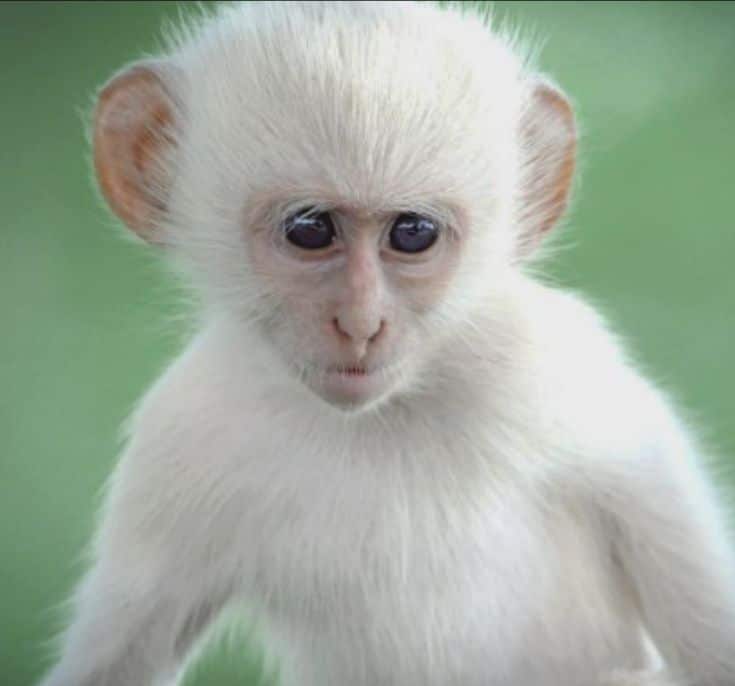
Life isn’t easy for these dazzling dudes. Hiding when you’re whiter than a snowball in Antarctica? Tough! But albino monkeys are smart cookies. And their senses? Sharper than jungle cat claws, they see through dappled light like it’s nothing.
So, next time you’re in the jungle (or even your backyard!), keep your eyes peeled for a white flash among the green. You might just meet one of these magical creatures, a living reminder that the world’s coolest stuff isn’t in storybooks, it’s right here, hiding in plain sight.
Related: 20 Funny Monkey Memes That Would Crack You Up
Albino Monkeys
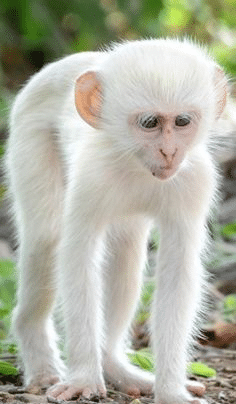
Rarely seen, monkey albino is born with no color in their skin, hair, or eyes. As a result, they usually have ashen skin and red eyes. They may have a reputation for beauty but struggle to survive in the wild.
They are easy pickings for predators, as they lack concealment. Additionally, they have difficulty seeing in the sun and are more likely to get skin cancer and sunburns.
Additionally, albino monkeys frequently experience eye issues and decreased reproduction. As a result, their populations are frequently small and dispersed. They are still a fascinating and cherished species.
Due to albinism, white monkeys are a relatively uncommon sight among primates. They are rare in the wild since experts only know a few. Melanin deficiency in the skin, hair, and eyes is a symptom of albinism, a hereditary disorder.
As a result, the monkey may experience visual issues and be more susceptible to skin cancer and sunburn. Both animals and humans can have albinism. However, it is significantly more common in people. But the 2015 discovery of an albino spider monkey shows primates can also have this disease.
Related: The Hyena Men of Nigeria: Who are they and controversies around them
Appearance

They stand out like confetti at a tea party, with skin pale as milk and fur whiter than snow. But being different isn’t easy in a world of camouflage. Hiding is trickier when you glow like a lighthouse!
But these monkeys are clever. They learned the daytime is their playground, basking in the sun while their leafy cousins snooze. And their senses? Super sharp! They see through dappled light like ninjas, hearing secrets the wind whispers.
Related: Cutest Animals in the World (2024): Top 13
Habitat
| Regions or Countries | Types of Environments | Habitat-Survival Relationship |
| 1. Congo Basin, Africa | Dense Rainforests | Albinos in the Congo Basin live in the lush, dense rainforests, where they can find plenty of food like fruits and leaves. – The thick canopy provides shelter from predators and harsh sunlight. |
| 2. Amazon Rainforest, South America | Diverse Ecosystems | Albinos in the Amazon Rainforest live in diverse ecosystems, including tropical rainforests and flooded forests. – Their habitat diversity gives them access to various food sources, helping them survive. |
| 3. Madagascar | Deciduous Forests | Albino lemurs in Madagascar are found in deciduous forests, which offer seasonal variations in food resources. – The deciduous forests have a mix of fruit-bearing trees and open spaces for foraging. |
| 4. Southeast Asia | Primary Rainforests | In Southeast Asia, albino gibbons and langurs live in primary rainforests, rich in biodiversity. – These rainforests have a continuous supply of fruits, leaves, and insects, supporting their dietary needs. |
| 5. Central Africa | Savannas and Woodlands | Some albinos in Central Africa are seen in savannas and woodlands, where they may have adapted to a different mix of vegetation. – These habitats may offer opportunities for ground-based foraging and social interactions. |
These monkeys have individual medical issues compared to normal monkeys and live in the jungle. They also prefer to eat fruits, leaves, and nuts.
Forests in the tropics are home to albino monkeys, and they often reside in trees. Because of their extreme shyness, albino monkeys usually avoid interacting with people. Because of this, nothing is known about their social structure or behaviour. These monkeys are believed to form compact groups of similar individuals.
In addition to providing safety from predators, these groupings enable the monkeys to communicate about potential food sources. Albino monkeys are relatively uncommon, and their white fur makes them susceptible to hunters. Because of this, they regard it as an endangered species.
Related: The monkey buffet festival of Thailand
Lifespan
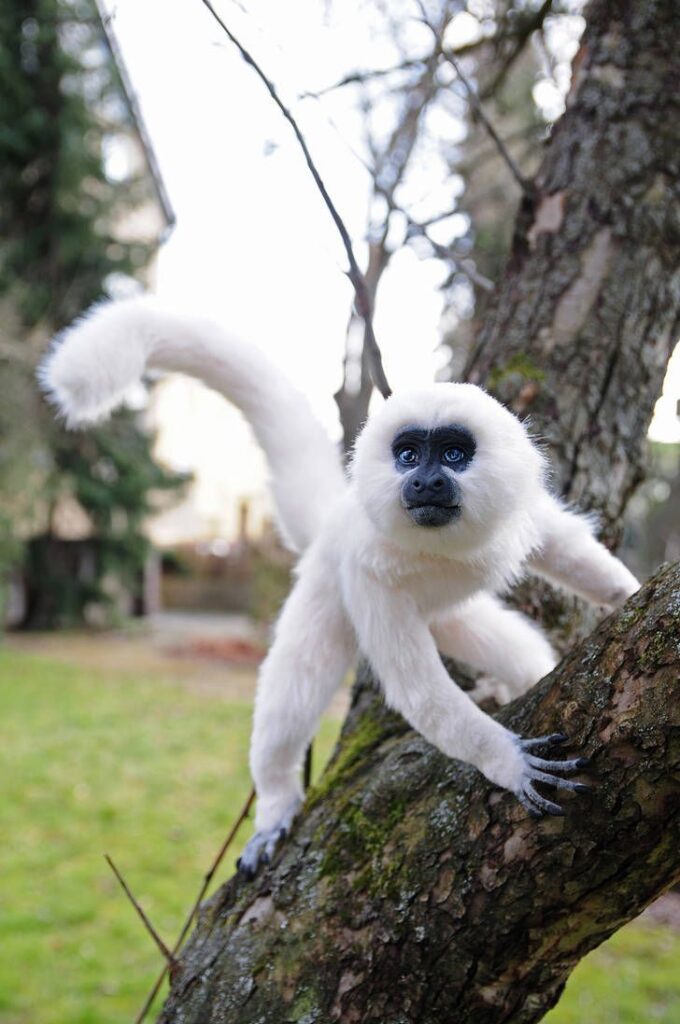
Albino monkeys have a shorter lifespan than their non-albino counterparts. According to research, a non-albino monkey can live up to 30 years in the wild, compared to the average lifespan of 10 years for albino monkeys. Albino monkeys can have substantially longer lives when kept in captivity.
Albino monkeys may live for up to 20 years if given a secure habitat and medical treatment, thanks to zoos and other institutions. Even though this is a lower average life span than non-albino monkeys, it is still a significant increase over what they might expect to live in the wild.
Nature
Albino monkeys share the same behavioural traits as their coloured counterparts. They are known for their agility, social interactions, and adeptness in navigating the intricate forest environment.
Diet
Like other monkeys, albino monkeys require a comparable diet to their non-albino relatives. Fruits, nuts, seeds, leaves, flowers, insects, and occasionally small vertebrates make up most of their food.
Depending on the type of monkey, different species may have different food preferences. While some monkeys are primarily frugivorous or fruit eaters, others have a more diversified diet that includes a mix of fruits, plants, and animal products.
Related: Racing Jokes That Will Make you Hilarious
Predators
Natural predators, such as large birds of prey and big cats, pose threats to albino monkeys. Their lack of camouflage makes them more vulnerable to predation.
Survival and Reproduction
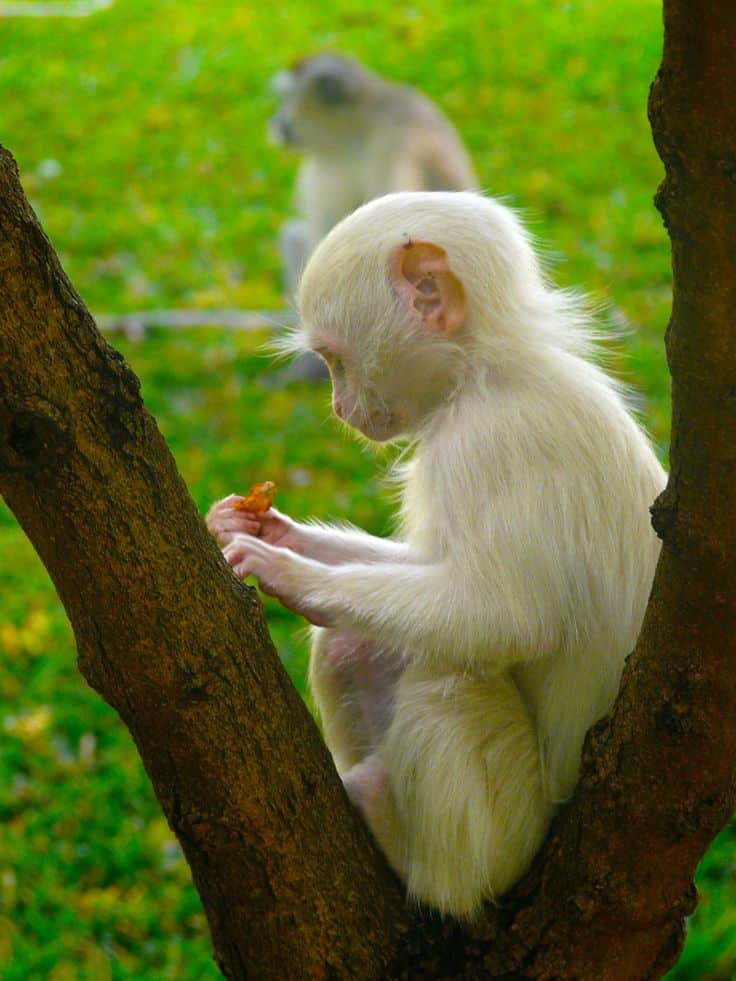
Because of their rarity and fragility, albino monkeys need special care to maintain their health. Always keep in mind that these monkeys are susceptible to sunlight. They must only spend a few minutes in the sun’s direct rays, which might cause a painful sunburn.
Instead, they must be kept indoors or in shady areas where they may be shielded from the light. Additionally, an albino monkey requires a lot of water to stay hydrated. It shows that they should eat many fruits and vegetables and drink fresh water. Last, albino monkeys must visit a vet at least once a year to remain healthy.
Reproduction, while not impossible, may face hurdles due to their distinctive appearance.
Related: 7 Tourist Attractions in Africa You Need to Visit
What is Albinism?
A genetic disorder called albinism impairs the synthesis of melanin, the pigment that gives skin, hair, and eyes their colour. It is caused by a mutation in many genes involved in the synthesis or distribution of melanin.
In most cases, albinism is inherited in an autosomal recessive form in albino animals, meaning that for an offspring to be affected by the trait, both parents must have the gene.
Many different animals, including monkeys, are affected by it. Regrettably, the health problems associated with albinism also affect albino monkeys.
Related: The Hyena Men of Nigeria: Who are they and controversies around them
Causes of Albinism in Monkeys
OCA and TYR gene mutations cause albinism, characterized by a total lack of melanin. Individuals’ survival and intraspecific interactions may be impacted by this syndrome, which has been deemed unusual in monkey species.
Albinism is believed to be brought on by genetic and environmental factors, although scientists are unsure about the exact reason.
For instance, albinism in monkeys might be brought on through inbreeding. According to research, albinism is more likely to run in families when two animals with the same genetic abnormality mate.
Stress from the environment also contributes to albinism’s emergence. Albinism is more common in monkeys living in stressful environments, such as those with excessive heat or food shortages.
Impact on Survival and Reproduction
The challenges posed by albinism significantly impact the survival rates of albino monkeys. Their reduced ability to blend into the environment increases the risk of predation. Additionally, reproductive success may face obstacles due to potential mate selection challenges.
Interesting Facts about Albino Monkeys
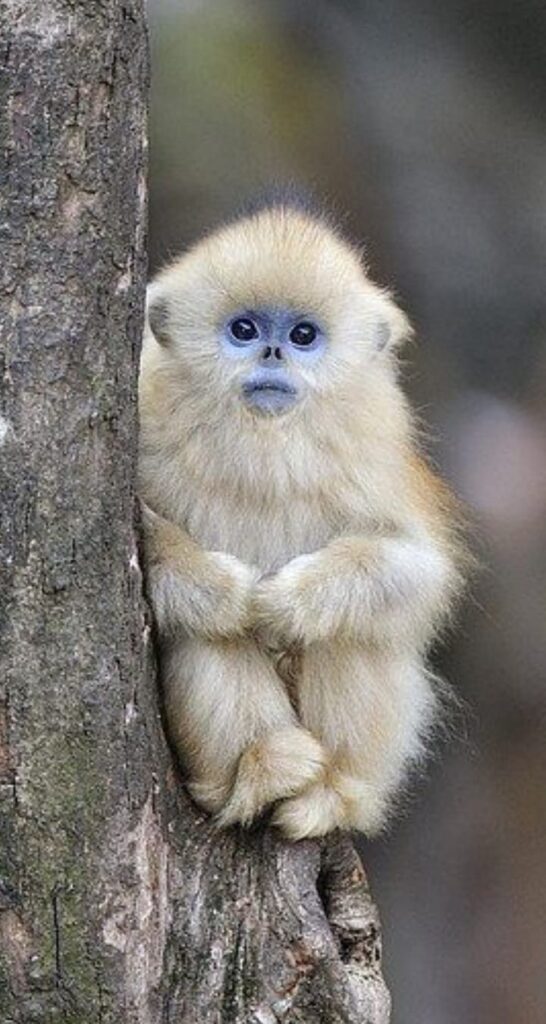
- These monkeys are stunning animals with a distinct and eye-catching appearance. Their fur is pure white or pale, and their skin and eyes lack the typical pigmentation seen in their non-albino counterparts. This striking appearance sets them apart from other primates in their habitat.
- They are highly sensitive to sunlight, which can damage their skin and eyes. They can easily sunburn and develop skin conditions when exposed to intense UV radiation. As a result, they often seek shade in their habitats to protect themselves from the sun’s harmful effects.
- Another challenge that monkeys face is camouflage. Their bright white colouration stands out against the lush greenery of their rainforest or woodland habitats, making them more vulnerable to predators. This lack of natural camouflage can be a significant disadvantage in the wild.
- Despite these challenges, monkeys are not loners. They are social animals that live in family groups or troops. They engage in various social behaviours, such as grooming and vocalizations, to strengthen bonds within the group. Despite their unique appearance, they often exhibit similar social structures and behaviours as their non-albino peers.
- They are fascinating animals that deserve our admiration and respect. They are rare and beautiful creatures with a unique genetic condition that affects their appearance and survival. By studying and conserving albino monkeys, we can learn more about their diversity and contribution to the primate world.
Related: What Is a Wet Koala, “Photo That Went Viral, Sparking Reactions and Inspiring Memes”
Conclusion
In the enchanting realm of tropical rainforests, albino monkeys stand as both enigmatic beings and symbols of the delicate balance of nature.
Their existence sparks intrigue and underscores the importance of conservation efforts to protect these rare and extraordinary creatures in their natural habitat.
If there are any questions, post them below.
Related: Top 15 Smart Animals in the World You Should Know
FAQ
Do albino monkeys exist?
Yes, they do.
What species of monkey is albino?
While albino monkeys are rare across all primate species, they have been reported in various monkey species, including toque macaques, bonnet macaques, chimpanzees, and rhesus monkeys. The occurrence of albinism in these primates is linked to specific genes that regulate the synthesis and distribution of melanin.
Are there half albino monkeys?
Half-albino monkeys are the result of a rare genetic mutation that affects certain body parts and does not necessarily pass down from generation to generation. This genetic condition results in a distinct appearance that sets them apart from both albino and fully pigmented monkeys.
The unique pigmentation pattern in half-albino monkeys can vary greatly. Some individuals may have patches or spots of pale colour, while others may have streaks or stripes of pale and pigmented fur. These unique markings provide a glimpse into the intricacies of genetic expression and result in visually striking and individualized appearances.
What are the causes of half-albino monkeys?
In monkeys, a genetic mutation that alters the distribution or synthesis of melanin in particular body regions results in half-albinisms. In the wild, whole and half-Alpino monkeys have both been seen.
Given that the albinism gene is not dominant, children cannot be born with the condition unless both parents have the gene.
What albino animals are rare?
Albino monkeys
Is the albino monkey legendary?
No.
